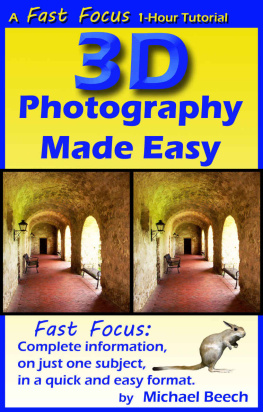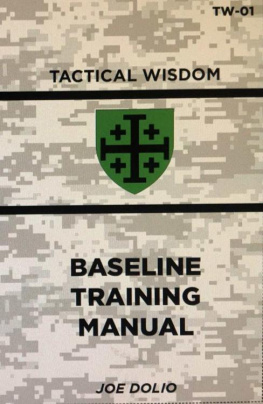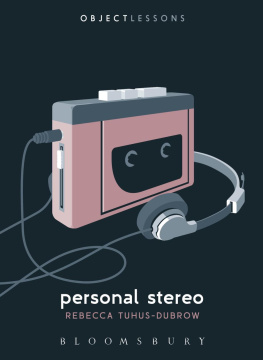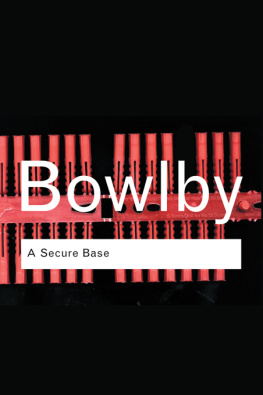~ ~ o ~ ~
Table of Contents
~ ~ o ~ ~
~ ~ o ~ ~
~~ o ~ ~
3D Photography Made Easy
by
Michael Beech
~ ~ o ~ ~
Copyright 2015 Michael Beech
Rev. 9/1/2015
Published by EnfoPress
~ ~ o ~ ~

3D Photography Made Easy
by
Michael Beech

Do you want to make 3D still photographs using your phone,tablet, digital, or film camera?
Do you want to learn, right now, how to make stunning 3Dpictures quickly and effortlessly? If so, 3D Photography MadeEasy was written with you in mind.
Maybe you have done some 3D photography, but have questions. Thenyou need to read this.
Are you having trouble making your 3Ds exciting and easy toview? Solving that problem is the entire purpose of this book.
Whether you are just beginning, or you know a bit about 3Dand just need help, the answers you are seeking will be found here (no droids,though). Additional aid will be found in the incredible 3D Photography Glossaryat the end.
3D images can be exciting and interesting to make and view.But there are pitfalls. As you may have experienced, poorly made 3Ds can bevery uncomfortableeven unpleasantto view. If you wish to make 3D images thatare exciting and pleasant to view, there are certain simple, time tested tricksyou can quickly learn to vastly improve your images. If you want to make 3Dsthat will make your friends say, Wow! and How did you do that? you willfind the answers here.
As in any discipline, it is important to develop good 3D habitsand avoid bad ones. I'll get you started fast, but I dont skip steps. So,well start together at the very beginning and proceed to the end, covering everystep, including the whys as well as the hows. This ensures thatyou will have a sound foundation upon which to build your skills. Once youlearn the basics, I will show you how you can find information to quicklyrefine your technique and make 3D stereo images of the highest quality.
If you already have 3D experience, I think you willbe pleasantly surprised by the wealth of tips, new techniques and creativeideas that you will find here to carry you to new heights of productivity andquality.
So, Grasshopper, come with me to first learn the essentialsthat every 3D photographer should know for a solid start in creating good 3Dimages. Then, in no time at all, youll be making magnificent, high qualitystereos.
A bit about me; I have an extensive background inphotography and 16 years in 3D photography. During that time I havewritten dozens of manuals, including 5 books on how to make outstanding,contest winning 3D images. Hundreds of photographers have studied my methods.I have coached hundreds more in online forums. I truly believe youwill be thrilled with what you learn from my books. Teaching photography,particularly 3D photography, is a passion for me and I have devotedcountless hours to working with those who wish to learn the subject.
Because of this, I know the exact steps required toget you up to speed fast. The information here is presented in a cut-to-the-chase,no bull, right-to-the-point manner... described clearly,concisely and without any formulas or obscure diagrams. Techno-speak is notspoken here.
Note
Just to be clear, you will be using a computer to"convert" the pictures you take into 3D images that you and yourfriends can enjoy. The software is free and simple to operate, but it is anecessary part of the process. If that is something you just can't abide, thenthank you for reading this far. But if you'll trust me, read on and I thinkyou will see that it ain't that bad.
Disclaimer
I have no connection with or any interest in thesoftware I recommend, either personal or financial. They are simply toolsthat I use and trust.
This tutorial is designed to establish sound stereographyskills without wandering off into the details and complexity of advancedstereography. Later, if you want to do more complex 3D's, such as video movies,the same techniques you learn here will apply. The aim, first, is to give yousound principles upon which you can rely with absolute confidence as youbuild your skills.
Dont be misled by the title of this book. Yes, theexplanations are designed to help the novice get a good, fast start but, onceyou absorb and utilize the concepts, you will have progressed well towardbecoming an advanced stereographer.
While reading, if you stumble over an unfamiliar 3D term,please refer to the appended 3D Photography Glossary (or do an in-booksearch of the glossary). Then, after you read this book, be sure to continue onto read the entire glossary. It is virtually an instruction manual for stereophotography all by itself. But, please wait to read it until after you haveread this manual.
Plus, I have another book, more advanced, that I think is soimportant for you to read, I intend to give it to you for free. As abonus, you will have access to many tips, secrets, and more on my website.
Heres to you spotting, photographing, and assembling somegreat stereos.
Best wishes for your success,
Mike Beech
License Note
This free ebook may be copied, distributed, reposted,reprinted and shared, provided it appears in its entirety without alteration,and the reader is not charged to access it. The images and text remain thecopyrighted property of the author and may not be reproduced or distributed inany manner outside of this document in its entirety.


Thank you very much for this tutorial. While I knew someof it, your procedure makes thing[s] a whole lot clearer, ordered, and willprobably end up making my alignments a lot better and pain free.
Chuck Isdale

Dear Mike,
You are offering new stereographers a wonderful helping hand.I have just read your first chapter and it is a clear explanation.
Peter Blyth

Mike,
I recently joined the group, but I have been dabblingin 3D photography for some time now as I have the time. I want tothank you for your excellent tutorials on alignment usingSPM... Your tutorial makes it possible to harness thewonderful tools it provides... I am anxious to learnmore and you are an excellent teacher. I feel now that I can make myimages do exactly what I want. Thanks again for this excellent tutorial.
Dale Smith

Hi Mike,
I'm back. I found your Digital 3D Stereo Guide so wellwritten and so informative I had to come back for more.
Best regards,
Barry


In order to make 3D photographs and prepare them for viewing,you need very little beyond a simple camera (or a tablet or phone with abuilt-in camera). You will need some computer software (the one you should useis free) to align your stereo photos digitally. There are two types of suchsoftware:
Dedicated 3D alignment computer software
General purpose photo editing software
Dedicated 3D Software
Dedicated software is used to turn your photos into 3D's. Youload your photos into it and follow some fairly simple steps (yeah, I know,when did that ever happen?) and great looking 3D's are the product. From thefollowing programs, choose the one that suits you and download it onto yourcomputer.
Next page










